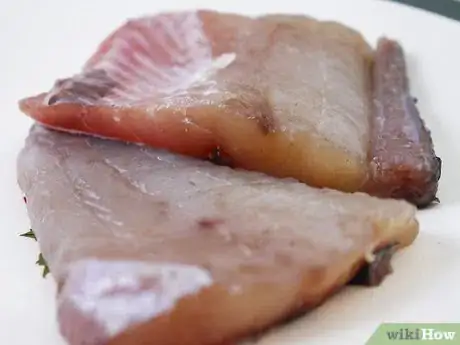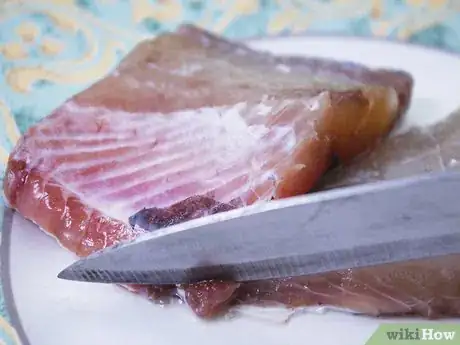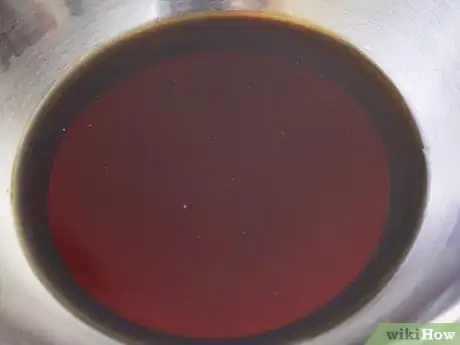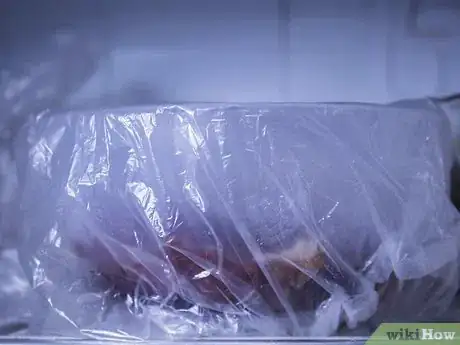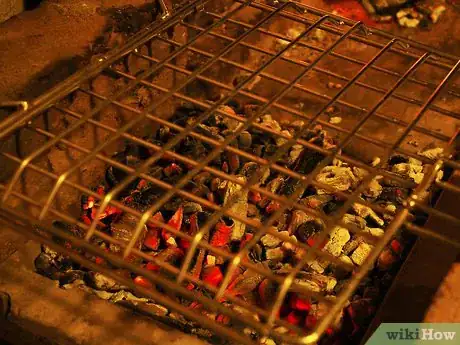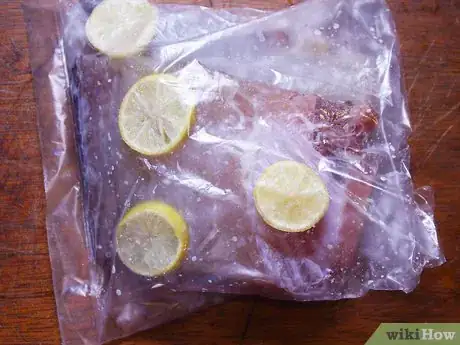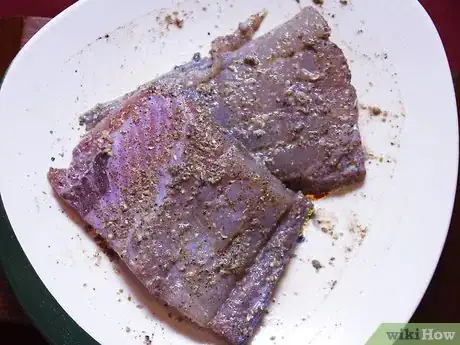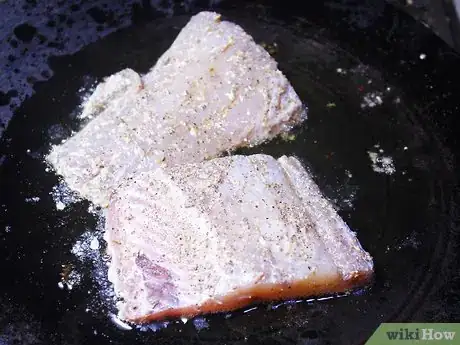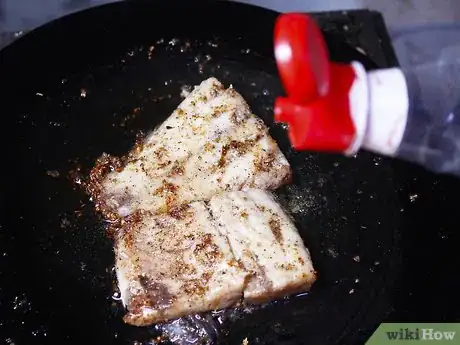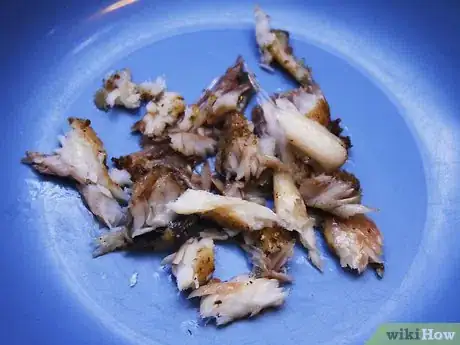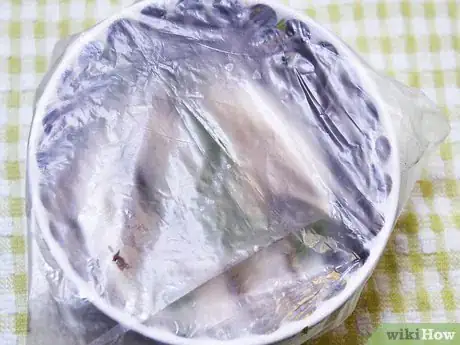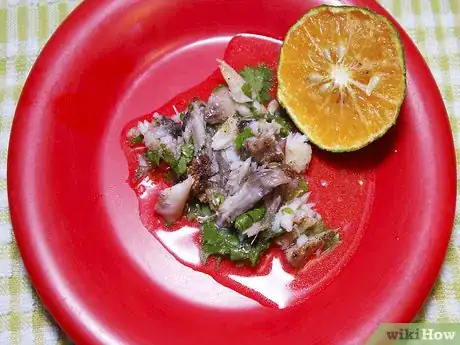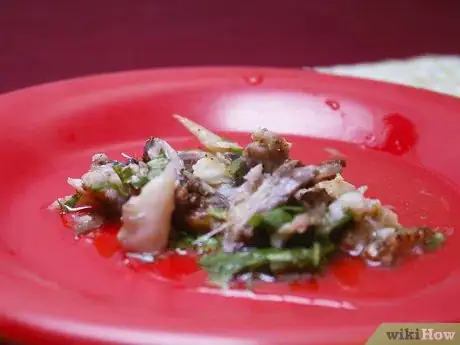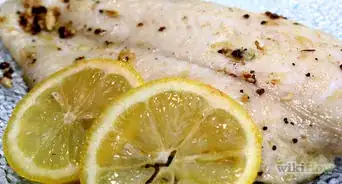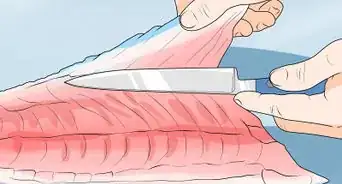This article was co-authored by wikiHow Staff. Our trained team of editors and researchers validate articles for accuracy and comprehensiveness. wikiHow's Content Management Team carefully monitors the work from our editorial staff to ensure that each article is backed by trusted research and meets our high quality standards.
There are 11 references cited in this article, which can be found at the bottom of the page.
This article has been viewed 308,703 times.
Learn more...
Shark is a delicacy in many parts of the world. It is often labeled as thresher, blacktip, mako, or bonito and sold as fillets or steaks. Shark meat needs to be cleaned and soaked in milk while fresh to eliminate unpleasant flavors. Then, you can cook the meat a number of different ways, including on the grill, in a pan, or as a ceviche.
Ingredients
Makes 2 servings
- 1 lb (0.45 kg) of shark
- 1⁄2 c (120 mL) of orange juice
- 2 US tbsp (30 mL) of soy sauce
- 1 US tbsp (15 mL) of lemon juice
- 1 clove of minced garlic
- ¼ teaspoon (0.57 g) of pepper
- 1 US tbsp (15 mL) of olive oil
Makes 4 servings
- 2 lb (0.91 kg) of shark
- 2 US tbsp (30 mL) of olive oil
- 2 tablespoons (28.4 g) of butter
- 4 tablespoon (32.0 g) of Cajun spice mix.
- 2 cloves of garlic, chopped
- 1 lemon, sliced
- 1⁄4 c (59 mL) of white wine or broth
Makes 4 to 8 servings
- 2 lb (0.91 kg) of shark
- 1⁄2 c (120 mL) of lime juice
- 1⁄2 c (120 mL) of lemon juice
- ½ cup (75 g) of diced red onions
- 1 cup (200 g) of chopped tomatoes
- 1 serrano chili, chopped
- 2 teaspoons (11.38 g) of salt
- 1 teaspoon (1.0 g) of oregano
- 1 teaspoon (1.80 g) of cayenne pepper
- Salt
- Pepper
- Avocados
- Tortillas
Steps
Cleaning and Slicing Shark Meat
-
1Get the highest quality shark meat available. Shark meat tends to spoil quickly and can be ruined if it isn’t handled properly. Choose shark meat with moist, translucent flesh. Make sure it isn’t flaky.[1]
- Buy shark from reputable supermarkets and fishmongers to ensure you get the best quality.
-
2Soak the meat in milk for 4 hours. Set the shark meat in a refrigerator-safe dish and submerge it in milk. Allowing it to soak eliminates the smell of ammonia and gamey flavor that a lot of fresh catches have. If you buy the shark from a quality source, it may have already been treated. If you don’t smell any ammonia, you may not need to soak the meat, although you can still do so to make sure the meat is at its best.[2]
- Fresh-caught shark needs to be soaked right after it is cleaned, or else the meat can become inedible.
- It doesn’t really matter what type of milk you use. Most people use any type of cow’s milk or buttermilk, but alternatives like soy milk or even lemon juice do well in a pinch. Plain milk is less acidic than buttermilk and lemon juice, so it can be a good option if you aren't making a ceviche.
Advertisement -
3Trim off the dark meat and skin with a paring knife. The dark meat comes from the areas around the shark’s skin. It includes blood lines and has a strong, unpleasant taste. Most recipes don’t call for shark skin, so you can remove it as well. If you’re buying shark from a store, chances are someone took care of this ahead of time, so you don’t need to worry about it.[3]
- You can remove the skin after you cook the meat. Leaving the skin on may help the meat retain more moisture.
-
4Cut the shark into steaks between 1 to 2 in (2.5 to 5.1 cm) thick. Slice the shark horizontally with a sharp knife to divide it up into smaller pieces. Avoid cutting the shark too thick or too thin. Shark meat is lean, so it can easily dry out when you cook it.[4]
- Marinating the shark after you slice it can help prevent it from drying out.
- Although steaks are a common way to cook and eat shark, you can also chop the steaks up into smaller pieces, such as when making kebabs or a ceviche.
Making Grilled Shark Steaks
-
1Mix a marinade to season the shark. You have plenty of options when adding flavor to grilled shark. For a simple but flavorful marinade, try combining 1⁄2 c (120 mL) of orange juice with 2 US tbsp (30 mL) of soy sauce and 1 US tbsp (15 mL) of lemon juice. Stir in 1 clove of minced garlic, ¼ teaspoon (0.57 g) of pepper, and 1 US tbsp (15 mL) of olive oil.[5]
- Choose a bowl big enough to hold the shark. You can also pour the marinade into resealable bags with the shark.
- Some other seasoning options include paprika, ginger, red pepper flakes, garlic powder, and rice wine vinegar.[6]
- For simpler steaks, rub them with olive oil, then sprinkle on salt and pepper. You can skip the marinade and throw them onto the grill right away. Try serving the shark with a sauce, such as a mango salsa.[7]
-
2Marinate the shark in the refrigerator for at least 30 minutes. Put the shark pieces in the marinade, making sure they are completely covered. Store the bowl in the refrigerator. For the best results, turn the shark pieces in the marinade after 15 minutes.[8]
- Expect to need the whole 30 minutes for the marinade to seep into the meat. You can leave the shark in the marinade for 1 or 2 hours to give it more flavor.
-
3Preheat an oiled grill on a medium setting. Take out the grate first, then rub or spray it with olive oil. A medium heat setting is about 350 °F (177 °C). To test the grill, hold your hand about 4 in (10 cm) over the grate. At the correct temperature, you will be able to hold your hand there for only 3 to 4 seconds.[9]
- If the grill gets too hot, it can scorch or dry out the meat. Watch the shark carefully if you use a different temperature.
-
4Grill the shark for 5 to 6 minutes per side. Leave the shark on the grill without moving it until you need to flip it. Use tongs or a spatula to carefully turn the shark over. When it is done cooking, it will be white and flaky. You can test it by cutting into it or touching it with a fork.[10]
- The length of time you need to cook the shark may vary depending on your grill and the thickness of the steak. Expect a 1 in (2.5 cm)-thick steak to take about 5 minutes per side.
-
5Store leftover shark for 3 to 4 days in the refrigerator. Move any leftovers into resealable bags or containers within 2 hours of cooking them. Throw away any leftovers that smell rancid or appear slimy.[11]
- You can also store the shark in the freezer for up to 3 months. Label the bags with today’s date so you know when you stored them.
Making Pan-Seared Shark Steaks
-
1Refrigerate the shark in a bag with lemon slices for 30 minutes. Set the shark pieces in the bag, then top them with a few lemon slices. Store the pieces, giving them plenty of time to absorb the lemon juice.[12]
- The shark’s age when it is caught can affect how it tastes. Older sharks tend to have a gamey flavor. Lemons help neutralize the unpleasant flavor and prepare the meat for searing.
-
2Heat olive oil and butter in a pan over medium-high heat. Pour about 2 US tbsp (30 mL) of olive oil in the pan, then add 2 tablespoons (28.4 g) of butter. Allow the butter to melt. Continue heating the pan until the oil shimmers and slides easily around the pan.[13]
- Baking the shark in the oven is also possible. Preheat the oven to 400 °F (204 °C), then cook the shark between 10 to 12 minutes.[14]
- To fry the shark, coat it in flour, then cook it in vegetable oil or shortening.
-
3Season the meat with salt, pepper, and spices. Lay the shark pieces out on a flat surface, then rub a spice mix over each side. A Cajun spice mix is an example of the flavors you can aim for. Add about 1 tablespoon (8.0 g) of the mix to each side of the meat. Also add 2 chopped up cloves of garlic.[15]
- To make a Cajun spice mix at home, combine salt, pepper, garlic powder, paprika, cayenne pepper, oregano, thyme, and red pepper flakes.[16]
-
4Cook the steaks about 6 minutes per side. Fit the shark pieces into the pan and wait for them to turn white and then a little brown on the bottom. Turn the pieces over with a spatula. When they are done cooking, they will look white and flakey. Set them aside on a plate when they’re done.[17]
- Test the shark with a knife or fork. In particular, pay attention to the center of each piece. Make sure it is cooked all the way through.
- The cooking time may vary depending on your oven and the heat setting you chose.
-
5Cook white wine or broth in the pan for 3 to 5 minutes. Pour about 1⁄4 c (59 mL) of either liquid into the pan. Stir the liquid in the pan to mix in any of the juice and meat left over from the shark. Continue cooking the liquid until it thickens into a nice sauce you can pour over the shark steaks.[18]
- Another option is to melt 1 tablespoon (14.2 g) of butter with 1 c (240 mL) of spiced rum and the juice from 1 lime.[19]
- If the shark hasn’t finished cooking yet, you can add the liquids while it is still in the pan.
-
6Store the leftovers for up to 4 days in the refrigerator. After serving the shark, move the leftovers into resealable plastic bags or containers. Label the containers as needed. Throw away any remaining pieces once they look rancid or begin emitting a sour odor.[20]
- You can store pan-fried shark for up to 3 months in the freezer.
Making Shark Ceviche
-
1Cut the shark into 1⁄2 in (1.3 cm) chunks. Clean and slice the shark into steaks about 1⁄2 in (1.3 cm) thick first. Then, use your knife to break the steaks down into smaller pieces. Make them into cubes about the same general size.[21]
- The pieces don’t have to be exactly the same size, but keep them small and thin so they cure properly.
-
2Toss the shark cubes with citrus juice and other seasonings. Add the shark pieces to a glass or ceramic casserole dish. For a basic ceviche, try using 1⁄2 c (120 mL) of both lime and lemon juice. Also add ½ a cup (75 g) of diced red onions and 1 cup (200 g) of chopped tomatoes. For seasonings, mix in 1 chopped serrano chili, 2 teaspoons (11.38 g) of salt, 1 teaspoon (1.0 g) of oregano, and 1 teaspoon (1.80 g) of cayenne pepper.[22]
- You can add or leave out additional ingredients. For instance, add cilantro for flavoring or leave out the cayenne pepper if you don’t like spicy food.
- In a ceviche, the acid in the citrus juices breaks down and cures shark meat similar to the way heat does without cooking it. Avoid making ceviche if you aren’t comfortable eating raw meat.
-
3Cover the dish in plastic wrap and refrigerate it. Seal the dish tightly to lock in the flavor. Using plastic wrap allows you to get a quick glimpse of how the shark is progressing as it cures. You can also use aluminum foil, since you will need to stir the ingredients every so often.
- Make sure the juices cover all of the meat before you store the dish.[23]
-
4Marinate the fish for about 4 hours, stirring occasionally. Every hour, peel back the plastic wrap and stir the contents of the dish to ensure all of the fish is exposed to the juices. The shark will turn white and flaky over time. When this happens, you can take the dish out of the refrigerator.[24]
- When the shark turns white, it is done. You don’t have to wait the full 4 hours.
-
5Serve the shark with tortillas and other toppings. You can warm up some tortillas to make ceviche tacos. Some other options include chopped cilantro and fresh avocado. Also, season the shark with salt and pepper to taste.[25]
-
6Refrigerate the leftovers for about 1 day. Remove the shark pieces from the dish, storing them separately. Rinse off the shark pieces to stop them from continuing to marinate. Then, move the leftovers into resealable plastic bags or containers as soon as possible. Ceviche made from fresh fish may last as long as 3 days, but throw the ceviche away if it starts smelling rancid or looks slimy.[26]
- Unfortunately freezing a ceviche doesn’t work too well. The shark tends to lose its texture, although it will still be edible.
Community Q&A
-
QuestionDo you need to marinate or use a special soak before cooking shark?
 Community AnswerYes. Gut and clean out the inside with water; leave it for half an hour or more to reduce the risk of mercury and other bad stuff.
Community AnswerYes. Gut and clean out the inside with water; leave it for half an hour or more to reduce the risk of mercury and other bad stuff. -
QuestionMy shark was dry and tough. What went wrong?
 QamarTop AnswererDid you overcook it? Make sure you cook the shark until it's opaque. The inside of the shark is best when it's moist. Make sure the temperature on your cooking device is correct, too. The wrong temperature can overcook the shark and cause it to be dry.
QamarTop AnswererDid you overcook it? Make sure you cook the shark until it's opaque. The inside of the shark is best when it's moist. Make sure the temperature on your cooking device is correct, too. The wrong temperature can overcook the shark and cause it to be dry. -
QuestionDo I need to rinse the lemon juice off after soaking the meat?
 QamarTop AnswererNo, the lemon juice should not be rinsed off.
QamarTop AnswererNo, the lemon juice should not be rinsed off.
Warnings
- Shark can contain high levels of mercury. For this reason, avoid consuming shark more than once or twice a month.⧼thumbs_response⧽
- Shark fin soup is condemned by many animal rights groups. Possessing a shark fin is illegal in some areas, so consult your local laws before buying one.⧼thumbs_response⧽
- Many species of sharks are endangered species. Be sure that any shark you purchase comes from a sustainable source.⧼thumbs_response⧽
- Ceviche involves raw fish. Only use fresh, quality shark for it. Avoid making it if you think raw fish may make you sick.⧼thumbs_response⧽
Things You'll Need
Cleaning and Slicing Shark Meat
- Knife
- Cutting board
- Dish
- Milk
- Measuring cup and spoons
Grilling Shark
- Bowl
- Whisk
- Refrigerator
- Grill
- Measuring cup and spoons
Pan-Searing Shark Steaks
- Bowl
- Whisk
- Pan
- Stove
Making Shark Ceviche
- Knife
- Cutting board
- Casserole dish
- Plastic wrap
- Measuring cup and spoons
References
- ↑ https://www.tablespoon.com/posts/how-to-prepare-and-cook-shark
- ↑ https://www.floridatoday.com/story/news/local/environment/sharks/2015/07/08/milk-secret-cooking-shark/29858145/
- ↑ http://www.foodreference.com/html/art-shark-7806.html
- ↑ https://www.tablespoon.com/posts/how-to-prepare-and-cook-shark
- ↑ https://www.recipetips.com/recipe-cards/t--3949/marinated-mako-shark.asp
- ↑ https://thestayathomechef.com/grilled-thresher-shark/
- ↑ https://www.esquire.com/food-drink/food/a10657/how-to-eat-shark-6183544/
- ↑ https://www.recipetips.com/recipe-cards/t--3949/marinated-mako-shark.asp
- ↑ https://www.esquire.com/food-drink/food/a10657/how-to-eat-shark-6183544/
- ↑ https://thestayathomechef.com/grilled-thresher-shark/
- ↑ https://www.thekitchn.com/how-long-does-fresh-fish-stay-good-tips-from-the-kitchn-219413
- ↑ http://www.thehungrymouse.com/2014/09/13/pan-seared-shark-steaks-swordfish-alternative/
- ↑ http://www.thehungrymouse.com/2014/09/13/pan-seared-shark-steaks-swordfish-alternative/
- ↑ https://www.recipetips.com/recipe-cards/t--3949/marinated-mako-shark.asp
- ↑ http://www.thehungrymouse.com/2014/09/13/pan-seared-shark-steaks-swordfish-alternative/
- ↑ https://www.allrecipes.com/recipe/149221/cajun-spice-mix/
- ↑ https://www.tablespoon.com/posts/how-to-prepare-and-cook-shark
- ↑ https://www.tablespoon.com/posts/how-to-prepare-and-cook-shark
- ↑ http://www.thehungrymouse.com/2014/09/13/pan-seared-shark-steaks-swordfish-alternative/
- ↑ https://www.thekitchn.com/how-long-does-fresh-fish-stay-good-tips-from-the-kitchn-219413
- ↑ https://www.esquire.com/food-drink/food/a10657/how-to-eat-shark-6183544/
- ↑ https://www.simplyrecipes.com/recipes/ceviche/
- ↑ https://www.esquire.com/food-drink/food/a10657/how-to-eat-shark-6183544/
- ↑ https://www.simplyrecipes.com/recipes/ceviche/
- ↑ https://www.esquire.com/food-drink/food/a10657/how-to-eat-shark-6183544/
- ↑ https://www.seriouseats.com/2011/07/the-food-lab-ceviche-and-the-science-of-marin.html
About This Article
Before you cook shark, trim off the dark meat and skin, and soak the meat in milk for 4 hours to get rid of the ammonia smell. Then, try grilling the shark over medium heat for 5-6 minutes per side. You can also pan-sear shark with some butter and oil in a pan over medium-high heat. Just heat up the butter and oil the pan, add the shark, and cook the meat for 6 minutes on each side. Whichever method you use, you can store the leftovers in the fridge for up to 4 days. To learn how to make shark ceviche, scroll down!
